10 Jul 2013
Central City Opera: Rocky Mountain High
Central City Opera’s meticulous staging of Our Town makes as good a case as is likely possible for Ned Rorem’s operatic version of that classic play.

Central City Opera’s meticulous staging of Our Town makes as good a case as is likely possible for Ned Rorem’s operatic version of that classic play.
Clearly the production team has endowed the staging with top-notch values, starting with Ken Cazan’s fluid, meaningful, resourceful stage direction. Thornton Wilder’s play that is the basis for this adaptation is, of course, celebrated for its non-linear theatricality, for breaking the fourth wall, for espousing profound truths with pithy means. Mr. Cazan has not only mined all the humanity in the well-known tale, but has even expanded its impact by nurturing a good deal of ‘poetry’ to emerge from Wilder’s deliberately homey prose.
He was enabled in his achievement by a nonpareil design team that made uniformly splendid contributions starting with the scenic environment created by Alan E. Muraoka. The choice of a plain stage floor and upstage wall of rough-hewn planks ably suggested New England, and proved a suitable neutral milieu that was a welcoming space for the addition of minimal set pieces placed by the actors. Mr. Muraoka also incorporated telling projections of sepia-toned photographs, some of the actual cast, that immeasurably added to the clarity of the narrative without ever overpowering the live action.
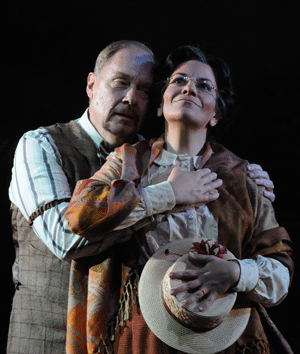 Kevin Langan as Dr. Gibbs and Phyllis Pancella as Mrs. Gibbs [Photo by Mark Kiryluk]
Kevin Langan as Dr. Gibbs and Phyllis Pancella as Mrs. Gibbs [Photo by Mark Kiryluk]
Costumer Marcy Froehlich has attired the cast in appropriate period regional dress that conveys their characters, singly and collectively, in highly nuanced and meaningful ways. Ms. Froehlich’s brilliant look for the minor personage of Mrs. Soames, all frills and finery and anything-but-the-usual-matron, was remarkably fine. Only one costume choice nagged at me: the Stage Manager in modern black disco-ready-dress with contemporary two-way headset and even a thermal drink cup. I appreciate the thought, but with the rest of the palette so subtly unobtrusive, this one anachronistic touch seemed self-conscious.
David Martin Jacques designed a lighting plot that was nothing short of exquisite. His subtle uses of pinpoint accurate isolated spots, gobo washes, perfectly calibrated fades, chilling back-lighting, and varied color filters was a veritable stage lighting Masters Class. Perhaps the highest praise for the collective technical achievement of Mssrs. Jacques and Muraoka, and Ms. Froehlich is how effortlessly and inevitably it all unfolded to the point of being sensed rather than noticed. Bravi tutti!
Mr. Rorem was fortunate indeed to have a (mostly) young and thoroughly accomplished cast to ennoble his score. The anchor of the piece was the accomplished soprano Anna Christy as Emily Gibbs. Ms. Christy is radiant in the part, believably youthful, sweetly endearing, and displaying a soaring lyric soprano that has never been heard to better advantage. The local mines around these parts can’t have an ounce of silver left in them since it all seems to have taken up residence in her throat. There was not a phrase Anna sang that was not deeply affecting, whether it was the conversational exchanges casually tossed off during courtship, the despairing post-mortem plunges to the depths of the chest voice, or the enchanting arcs and leaps to the stratosphere. Emily owns the last act, and Anna Christy made the extended scena her own with a traversal of such intense and flawless vocalization I can hear it still.
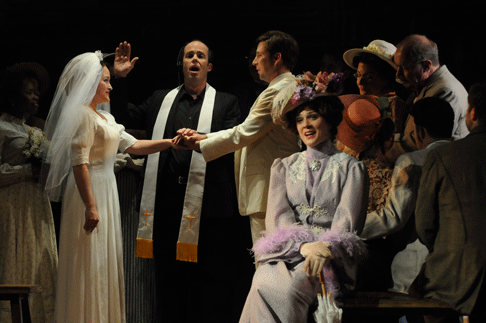 Behind, L to R: Anna Christy as Emily Webb, Vale Rideout as Stage Manager, William Ferguson as George Gibbs, Phyllis Pancella as Mrs. Gibbs, Kevin Langan as Dr. Gibbs; in Foreground: Claire Shackleton as Mrs. Soames. [Photo by Mark Kiryluk]
Behind, L to R: Anna Christy as Emily Webb, Vale Rideout as Stage Manager, William Ferguson as George Gibbs, Phyllis Pancella as Mrs. Gibbs, Kevin Langan as Dr. Gibbs; in Foreground: Claire Shackleton as Mrs. Soames. [Photo by Mark Kiryluk]
William Ferguson was a perfect match as her love interest, the slightly gangly, earnest George Gibbs. Mr. Ferguson modulated his pure, clear tenor to good effect and exerted utter control in flights to the upper regions. Although the tone is slender, he has excellent projection and superb diction, and his collegial musicality made the important George-Emily duets real highpoints of the evening. Vale Rideout made an indelible impression as the Stage Manager, mastering some cruelly high and exposed pronouncements with professional skill, and meandering his way around multiple Britten-esque melismas with aplomb. Mr. Rideout has had considerable success with such parts and it is easy to see why. He has a reliable technique and he skillfully uses it to master every challenge of such wide-ranging, musically diverse vocal writing. Moreoever, Vale has an easy, natural stage demeanor that is effortlessly engaging.
Kevin Langan’s solid, orotund bass was an excellent match for the role of Dr. Gibbs, and he memorably dominated the scene chiding his son to chop the wood for his mother. Phyllis Pancella proved a thoroughly lovely Mrs. Gibbs, her plangent mezzo falling easily on the ear. Her graveyard advisories and weighted asides were hauntingly beautiful. As Mr. Webb, John Hancock not only had a towering physical presence but had a voice to match: a mellifluous, responsive baritone that rang out soundly in the house. Sally Wolf was a fine partner with her sympathetic Mrs. Gibbs, her individual, opaque mezzo adding variety and texture to the vocal roster.
This performance also featured two talented young artists whose stock is no doubt on the rise. As Mrs. Soames, Claire Shackleton wrung every possible effect out of her brief turn while singing with a ripe mezzo of polished sheen and warmth. And Kevin Newell treated us to an appealing, well-focused tenor, and proved to be a touching embodiment of the drunken choir master Simon Stimson. Both singers made mighty, moving contributions to the graveyard scene ensembles. Though having less meaty assignments, there were solid additions to the evening’s success from Robert Murphy (Joe Crowell), Alexander Elliott (Frank), and Isaac Bray (Sam) whose horse play, high spirits and robust singing enlivened Act One.
Whether Our Town is a great opera, time will tell. What I can tell you now is that this was a great production, owing in no small part to the assured and sensitive conducting from Christopher Zemliauskas. The Maestro got maximum effect from Rorem’s small orchestration, eliciting a great variety of color and even a suggestion of plush ensemble from his small, talented group. His coordination with the stage was immaculate, and he drew exceptionally sensitive singing from the soloists as well as Levi Hammer’s well-tutored chorus.
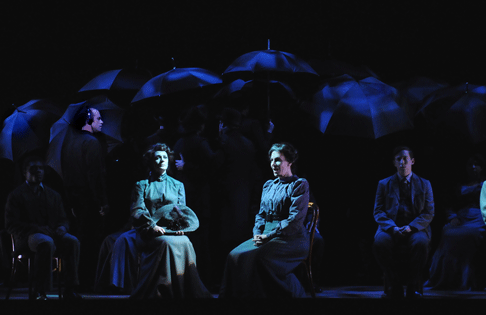 Vale Rideout as Stage Manager, Claire Shackleton as Mrs. Soames and Phyllis Pancella as Mrs. Gibbs. [Photo by Mark Kiryluk.]
Vale Rideout as Stage Manager, Claire Shackleton as Mrs. Soames and Phyllis Pancella as Mrs. Gibbs. [Photo by Mark Kiryluk.]
I have great admiration for Ned Rorem as one of America’s finest, most prolific song writers. He is almost unmatched at setting texts and creating accessible yet fresh melodies. While his harmonic vocabulary comes across to me as largely neo-classical, and while there are moments in the compact score that recall other big name composers, he has proven over the years to have his own voice. Still, as the evening progressed, I did wonder if Mr. Rorem was too often taking an easy, “accessible” way out. Themes that have an initial appeal seem to either get truncated or fail to fully blossom into something more engaging or enduring. J.D. McClatchy’s libretto, while functional, occasionally slips into rhymes of the “Roses are red, violets are blue” ilk that are jarringly not Wilder. At opera’s end, I found myself wondering if the authors just might have set out to simply create a piece with a popular title and modest requirements that may encourage wider performances. I think that they could have been substantially more diligent in meaningfully serving the source, Our Town.
For proof positive that a composer and librettist can not only perfectly serve their source material, but actually improve upon it, we had only to wait until the sparkling performance of Il Barbiere di Siviglia. Since my last experience with Rossini’s classic comedy was a dreary and charmless production at the very festival named for the composer, I can happily report that CCO has out-Pesaro’d Pesaro with a bustling, effervescent, laugh-out-loud-funny staging peopled with some of today’s best young singers.
Daniel Belcher was a firecracker of a barber, and his bright, vibrant baritone served the role of Figaro well. Animated and witty, Mr. Belcher showed off an uncommonly wide range which encompassed some astonishingly easy, ringing high phrases. While his Largo al factotum was the usual crowd-pleaser, truth to tell it came across as just a bit noisy and rhythmically unruly. But once past that well-beloved set piece, Daniel settled down to a finely-drawn vocal portrayal that was steady and incisive.
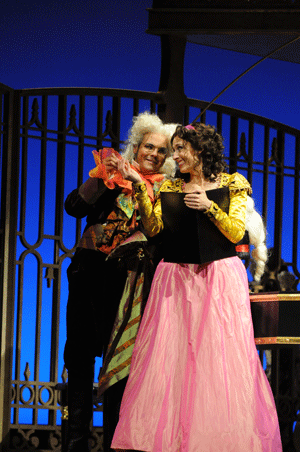 David Portillo as Almaviva and Jennifer Rivera as Rosina. [Photo by Mark Kiryluk]
David Portillo as Almaviva and Jennifer Rivera as Rosina. [Photo by Mark Kiryluk]
Statuesque Jennifer Rivera was not only the very funniest Rosina I have ever seen, she was also one of the most musically impressive, starting with a tone as sumptuous as heavy cream. Moreover, she commands a striking ability to retain an evenness of production from top to bottom and back again as she tosses off coloratura with aplomb and distinction. This was clearly not Ms. Rivera’s first encounter with the role since she brought a wealth of seasoned detail, effortless grace, and practiced humor to her characterization. Jennifer can execute a dead-pan ‘mug’ with a comedic accuracy that would rival Carol Burnett, and her ‘take’ after Lindoro reveals his true identity was alone worth the price of admission.
As Almaviva,/Lindoro David Portillo was so dapper and well-scrubbed that it was easy to understand why he would intrigue the oppressed heroine. The fact that his well-schooled tenor is sweetly communicative completes the seduction. Mr. Portillo has stage savvy to spare and he throws himself into his disguised visits to Bartolo’s house with abandon. His lisping, over-the-top music master yielded especially fun-filled results. In a role that can be the most ungrateful in the opera, David scored a solid success owing to his winning personality and committed, balanced vocalizing.
Arguably the show’s very finest singing came from the accomplished Bartolo, Patrick Carfizzi (and how often can one say that about a Barbiere performance?). Mr. Carfizzi’s impressive bass is as powerful as it is handsome. Make no mistake, he certainly knows how to use a full arsenal of buffo vocal tricks and colors to nail his laughs and etch his scheming Don, but then he can suddenly take our breath away with a finely sung declamation that is remarkably elegant. This was Rossinian (or ‘anyone-else-ian’) singing and acting of the highest order, a sublime accomplishment.
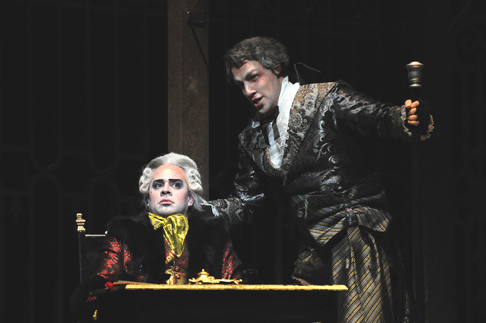 Patrick Carfizzi as Bartolo and Grigory Soloviov as Don Basilio. [Photo by Mark Kiryluk]
Patrick Carfizzi as Bartolo and Grigory Soloviov as Don Basilio. [Photo by Mark Kiryluk]
If Grigory Soloviov’s Basilio was not quite in the same league, it nevertheless had much to recommend it such as a lanky physicality and an equally imposing, sonorous bass instrument. La calunnia was a bit under-characterized and the sustained top tones, though well-tuned, tended to turn diffuse. Once past this first scene however, Mr. Soloviov seemed to noticeably relax his stage deportment, and a pleasant ping ingratiated itself into his increasingly pointed singing. Alexandra Loutsion’s bounteous mezzo gave much pleasure and contributed substantially to the ensembles. Given an usual amount of stage time, Ms. Loutsion relished the opportunity and she landed every recurring sneeze gag with precise timing. There is a velvety richness and refinement in her voice that madeIl vecchiotto cerca moglie a real pleasure (rather than the more usual audience endurance test as a character mezzo “acts” her way through it in the late autumn of a career).
Shea Owens began the afternoon with great promise, his turn as Fiorillo well-served by his smoothly produced baritone with its attractive youthful bloom. And Ian O’Brien actually threatened to steal a scene or two (or three) with his scruffy, bewildered Ambrogio. Indeed when he was given a lengthy sustained note to sing in an improvised moment of recitative, Mr. O’Brien not only stopped the show, but his accomplished outburst left us wanting more. Much more.
Conductor John Baril kept the musical side of things percolating along. Maestro Baril accommodated and partnered with his singers with skill, and he made some bold choices of tempo for a few of the most well known moments. The orchestra acquitted themselves cleanly if without a distinctive flair. If I had one wish, it would be that the large ensembles, especially the Act One finale, could have been tighter. Perhaps it was the busy staging, but there seemed to be few avoidable lapses in coordination that briefly marred an otherwise wholly creditable afternoon of bubbly music-making.
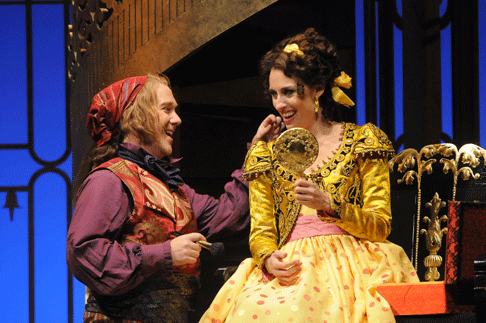 Daniel Belcher as Figaro and Jennifer Rivera as Rosina. [Photo by Mark Kiryluk]
Daniel Belcher as Figaro and Jennifer Rivera as Rosina. [Photo by Mark Kiryluk]
How does a director approach such a thrice familiar repertory staple? I always find that first it is best to stay honest to the piece, and if you can’t be, then at least stay out of the way. Director Marc Astafan was most successful when his staging was most truthful which is to say much of time. He also excelled at creating fresh business during the recitatives that filled out the individual characters, their motivations, and their unique quirks.
But Mr. Astafan was less accomplished at the large group scenes that were prone to busy-ness for its own sake. Some of the amassed forces are required by the score, but others were invented and imposed on the comedy, sometimes to its detriment. Figaro’s entrance involved his pulling an elaborate traveling salesman’s wagon on and attracting a crowd. Not a bad idea but it got reduced to bopping and bouncing mute choristers pulling focus from one of opera’s most famous arias. Wiggling rumps back and forth in unison is not a visual counterpart to Rossini’s wit.
I do applaud the individualization of ensemble members but let’s please keep them in character and in the character of the work. Having nuns hike up their skirts and goofily hoof it out of the rainstorm is more American vaudeville shtick than 19th Century Italian operatic performance practice.
On the other hand, making the would-be lovers act undeniably horny in the lesson scene yielded excellent opportunities. Their outrageous smooching and rolling around behind Bartolo’s back seemed aptly inspired by commedia dell’arte. I didn’t envy Mr. Astafan’s need to move his cast around a crowded, smallish stage. It sometimes required “blocking by the inch” and the traffic management of both finales was expertly managed.
Arnulfo Maldonado provided a very workable set design, dominated by a spectacular two-tiered, circular wrought iron structure that at once suggested a birdcage and a Spanish mansion. That magnificent framework afforded surprisingly many uses of levels and entrances with the simple addition of a flown front gate, suitably effective set pieces, and a scrim as the grand drape. Sara Jean Tosetti’s lively, fanciful costumes added immeasurably to the audience-pleasing success of the proceedings, although when Figaro donned his hat something about his look found me recalling Gene Wilder as Willy Wonka, a Freudian leap best left unexplored. Mr. Jacques’ well-judged, vivid lighting left nothing to be desired, and Dave Bova’s wig and make-up design served the performers well.
At eighty-five hundred feet above sea level, if the ‘high’ quality of these two festival productions is any indication, Central City Opera is scaling the heights in every way.
James Sohre
Production and cast information:
Our Town
Stage Manager: Vale Rideout; Dr. Gibbs: Kevin Langan; Mrs. Soames: Claire Shackleton; Geroge Gibbs: William Ferguson; Emily Webb: Anna Christy; Mrs. Webb: Sally Wolf; Joe Crowell: Robert Murphy; Frank: Alexander Elliott; Sam: Isaac Bray; Lady in Balcony: Leah Bobbey; Man in Audience: Jason Ryan; Mr. Webb: John Hancock; Simon Stimson: Kevin Newell; Mrs. Gibbs: Phyllis Pancella; Conductor: Christopher Zemliauskas; Director: Ken Cazan; Set Design: Alan E. Muraoka; Costume Design: Marcy Froehlich; Lighting Design: David Martin Jacques; Wig and Make-Up Design: Dave Bova; Chorus Master: Levi Hammer
Il Barbiere di Siviglia
Fiorello: Shea Owens; Count Almaviva: David Portillo; Figaro: Daniel Belcher; Rosina: Jennifer Rivera; Don Bartolo: Patrick Carfizzi; Berta: Alexandra Loutsion; Ambrogio: Ian O’Brien; Don Basilio: Grigory Soloviov; Official: William Dwyer; Notary: Welsey Gentle; Coductor: John Baril; Director: Marc Astafan; Set Design: Arnulfo Maldonado; Costume Design: Sara Jean Tosetti; Lighting Design: David Martin Jacques; Wig and Make-Up Design: Dave Bova; Chorus Master: Levi Hammer